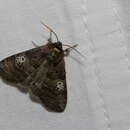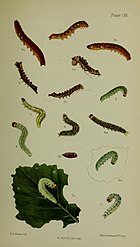pt-BR
nomes no trilho de navegação


Tethea ocularis és una papallona nocturna de la subfamília Thyatirinae de la família Drepanidae. Es troba per tota Europa continental i té una distribució escampada a Anglaterra i Gal·les, tot i que és absent d'Escòcia i Irlanda.
L'envergadura alar és de 35-45 mm. Les ales anteriors de color marró fosc estan marcades amb línies blanques centrades que es veuen més aviat com el nombre 80. Les ales posteriors són de color gris. L'espècie vola de maig a juliol i se sent atreta per la llum i el sucre.[1]
La larva grisa i blanca s'alimenta de pollancres i altres espècies del gènere Populus. L'espècie passa l'hivern com a pupa.
Tethea ocularis és una papallona nocturna de la subfamília Thyatirinae de la família Drepanidae. Es troba per tota Europa continental i té una distribució escampada a Anglaterra i Gal·les, tot i que és absent d'Escòcia i Irlanda.
Gwyfyn sy'n perthyn i urdd y Lepidoptera yw tant ffigwr wyth deg, sy'n enw gwrywaidd; yr enw lluosog ydy tannau ffigwr wyth deg; yr enw Saesneg yw Figure of Eighty, a'r enw gwyddonol yw Tethea ocularis.[1][2] Mae i'w ganfod drwy Ewrop gyfandirol a chlystyrau bychain yng Nghymru a Lloegr.
35–45 mm ydy lled ei adenydd agored ac arnynt ceir marc tebyg i'r rhif "80". Mae'n hedfan rhwng Mai a Gorffennaf a chaif ei ddenu at olau.
Mae'r siani flewog llwyd a gwyn yn byw ar ddail y boplysen yn enwedig y Populus tremula.
Gellir dosbarthu'r pryfaid (neu'r Insecta) sy'n perthyn i'r Urdd a elwir yn Lepidoptera yn ddwy ran: y gloynnod byw a'r gwyfynod. Mae'r dosbarthiad hwn yn cynnyws mwy na 180,000 o rywogaethau mewn tua 128 o deuluoedd.
Wedi deor o'i ŵy mae'r tant ffigwr wyth deg yn lindysyn sy'n bwyta llawer o ddail, ac wedyn mae'n troi i fod yn chwiler. Daw allan o'r chwiler ar ôl rhai wythnosau. Mae pedwar cyfnod yng nghylchred bywyd glöynnod byw a gwyfynod: ŵy, lindysyn, chwiler ac oedolyn.
Gwyfyn sy'n perthyn i urdd y Lepidoptera yw tant ffigwr wyth deg, sy'n enw gwrywaidd; yr enw lluosog ydy tannau ffigwr wyth deg; yr enw Saesneg yw Figure of Eighty, a'r enw gwyddonol yw Tethea ocularis. Mae i'w ganfod drwy Ewrop gyfandirol a chlystyrau bychain yng Nghymru a Lloegr.
35–45 mm ydy lled ei adenydd agored ac arnynt ceir marc tebyg i'r rhif "80". Mae'n hedfan rhwng Mai a Gorffennaf a chaif ei ddenu at olau.
Mae'r siani flewog llwyd a gwyn yn byw ar ddail y boplysen yn enwedig y Populus tremula.
Der Augen-Eulenspinner (Tethea ocularis) ist ein Schmetterling aus der Familie der Eulenspinner und Sichelflügler (Drepanidae).
Die Falter erreichen eine Flügelspannweite von 32 bis 38 Millimetern. Sie haben graubraune oder grauschwarze Vorderflügel, die in der Mitte eine breite helle Querbinde aufweisen. Diese wird an beiden Seiten durch zwei schwarze dünne Querbinden eingefasst. In der hellen Querbinde finden sich am Rand ein runder und ein einer „8“ ähnlich sehender heller Fleck mit dunklem Kern.
Die Raupen werden ca. 40 Millimeter lang. Sie sind im Alter weißlich-grün und haben einen braunen Kopf, der abgeflacht ist. Sie haben eine sehr schwache dunkle Zeichnung und am ersten Segment an der Seite einen schwarzen Punkt. Die jungen Raupen haben eine deutlichere dunkle Zeichnung.
Sie kommen in Süd- und Mitteleuropa östlich bis Japan in warmen und feuchten Laubwäldern mit Pappelbeständen, besonders in Auwäldern, Strom und Flusstälern aber auch in Parks vor. Sie fehlen im Norden von Skandinavien und Großbritannien. Die Art ist in ökologischer Sicht recht empfindlich und stellt hohe Ansprüche an die Biozönose. Daher ist ihr Vorkommen recht lokal und auf artenreiche Biozönosen mit wenig intensiven Bewirtschaftungsformen reduziert.[1]
Die Tiere sind nachtaktiv und lassen sich erst nach Mitternacht leicht durch künstliches Licht locken.
Die Falter fliegen in zwei Generationen von Anfang Mai bis Anfang Juli und von Mitte Juli bis Mitte August. Die Raupen aus den Eiern der ersten Generation findet man von August bis September, die der zweiten von Juli bis September des nächsten Jahres.[2]
Die Raupen ernähren sich von den Blättern der Zitterpappel (Populus tremula) und anderen Pappelarten (Populus).
Die Weibchen legen ihre Eier in kleinen Gruppen auf Blätter. Sie bedecken sie und die umgebende Oberfläche des Blattes mit Schuppen. Die nachtaktiven Raupen verstecken sich am Tag zwischen zwei miteinander versponnenen Blättern. Sie verpuppen sich am Boden zwischen trockenem Laub in einem lockeren Gespinst und schlüpfen erst nach dem Winter.
Der Augen-Eulenspinner (Tethea ocularis) ist ein Schmetterling aus der Familie der Eulenspinner und Sichelflügler (Drepanidae).
Tethea ocularis, the figure of eighty, is a moth of the family Drepanidae. The species was first described by Carl Linnaeus in his 1767 12th edition of Systema Naturae. It is found throughout Continental Europe and has a scattered distribution in England and Wales, although it is absent from Scotland and Ireland.
The wingspan is 35–45 mm; the dark brown forewings being marked with dark-centred white stigmata which do look rather like the number 80. The hindwings are grey. The species flies from May to July[1] and is attracted to light and sugar.
The grey and white larva feeds on poplar and aspen. The species overwinters as a pupa.
Tethea ocularis, the figure of eighty, is a moth of the family Drepanidae. The species was first described by Carl Linnaeus in his 1767 12th edition of Systema Naturae. It is found throughout Continental Europe and has a scattered distribution in England and Wales, although it is absent from Scotland and Ireland.
 Illustration from John Curtis's British Entomology Volume 5
Illustration from John Curtis's British Entomology Volume 5  Fig 7, 7a larvae after final moult
Fig 7, 7a larvae after final moult The wingspan is 35–45 mm; the dark brown forewings being marked with dark-centred white stigmata which do look rather like the number 80. The hindwings are grey. The species flies from May to July[1] and is attracted to light and sugar.
The grey and white larva feeds on poplar and aspen. The species overwinters as a pupa.
De peppel-orvlinder (Tethea ocularis) is een nachtvlinder die behoort tot de Drepanidae, de eenstaartjes. De vlinder heeft een voorvleugellengte van 16 tot 20 millimeter. De soort overwintert als pop tussen het blad waarmee het op de grond valt.
De imago kan verward worden met de orvlinder (Tethea or) maar bij die vlinder zijn de "80"- of "OR"-vormige vlekken minder duidelijk, en heeft de vleugel tussen die vlekken en de vleugelbasis meer golflijnen die ook sterker gegolfd zijn.
De waardplant van de peppel-orvlinder is ratelpopulier en in mindere mate andere populiersoorten.
De peppel-orvlinder is in Nederland en België een gewone soort, die verspreid over het hele gebied voorkomt.De vliegtijd is van begin mei tot half augustus in één generatie.
De peppel-orvlinder (Tethea ocularis) is een nachtvlinder die behoort tot de Drepanidae, de eenstaartjes. De vlinder heeft een voorvleugellengte van 16 tot 20 millimeter. De soort overwintert als pop tussen het blad waarmee het op de grond valt.
De imago kan verward worden met de orvlinder (Tethea or) maar bij die vlinder zijn de "80"- of "OR"-vormige vlekken minder duidelijk, en heeft de vleugel tussen die vlekken en de vleugelbasis meer golflijnen die ook sterker gegolfd zijn.
Øyehalvspinner (Tethea ocularis) er en sommerfugl som tilhører familien halvspinnere (Drepanidae). I Norge finnes den vestover til Vest-Agder.
En middelsstor (vingespenn 34 – 40 mm), ganske kraftig spinner som kan minne om et nattfly (Noctuidae). Lett å kjenne på den hvite "80"-tegningen på forvingen. Kroppen er kort og tykk, brunlig, antennene trådformede. Forvingen er forholdsvis smal, grålig brun, med to uregelmessige, svarte tverrlinjer rundt midten. Mellom disse er det en karakteristisk, hvit tegning som kan leses som "XO" eller "80" (venstre vinge). I vingespissen er det en kort, svart strek. Bakvingen er brunlig hvit. Larven er blek og delvis gjennomsiktig, sylindrisk med brungul hodekapsel.
Øyehalvspinneren finnes i skogbryn og løv- og blandingsskog med innslag av osp (Populus tremula), som er larvenes næringsplante. De voksne sommerfuglene flyr om natten i mai – juli.
Arten finnes i Europa og videre østover til Korea. I Norge finnes den fåtallig og lokalt langs Oslofjorden og Sørlandskysten vest til Farsund.
Øyehalvspinner (Tethea ocularis) er en sommerfugl som tilhører familien halvspinnere (Drepanidae). I Norge finnes den vestover til Vest-Agder.
Tethea ocularis é uma espécie de insetos lepidópteros, mais especificamente de traças, pertencente à família Drepanidae.[1]
A autoridade científica da espécie é Linnaeus, tendo sido descrita no ano de 1767.
Trata-se de uma espécie presente no território português.
Tethea ocularis é uma espécie de insetos lepidópteros, mais especificamente de traças, pertencente à família Drepanidae.
A autoridade científica da espécie é Linnaeus, tendo sido descrita no ano de 1767.
Trata-se de uma espécie presente no território português.